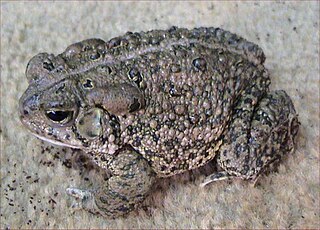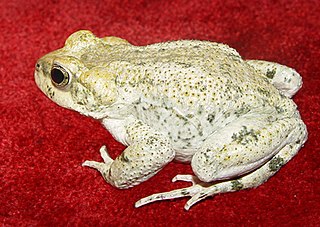
The cane toad, also known as the giant neotropical toad or marine toad, is a large, terrestrial true toad native to South and mainland Central America, but which has been introduced to various islands throughout Oceania and the Caribbean, as well as Northern Australia. It is the world's largest true toad. It is a member of the genus Rhinella, which includes many true toad species found throughout Central and South America, but it was formerly assigned to the genus Bufo.

The common toad, European toad, or in Anglophone parts of Europe, simply the toad, is an amphibian found throughout most of Europe, in the western part of North Asia, and in a small portion of Northwest Africa. It is one of a group of closely related animals that are descended from a common ancestral line of toads and which form a species complex. The toad is an inconspicuous animal as it usually lies hidden during the day. It becomes active at dusk and spends the night hunting for the invertebrates on which it feeds. It moves with a slow, ungainly walk or short jumps, and has greyish-brown skin covered with wart-like lumps.

A true toad is any member of the family Bufonidae, in the order Anura. This is the only family of anurans in which all members are known as toads, although some may be called frogs. The bufonids now comprise more than 35 genera, Bufo being the best known.

The Carchi Andes toad, Rhaebo colomai, is a species of toad endemic to the western slopes of the Andes in northern Ecuador and southern Colombia. It is listed as an endangered species due to a restricted range and habitat loss.

Woodhouse's toad is a medium-sized true toad native to the United States and Mexico. There are three recognized subspecies. A. woodhousii tends to hybridize with Anaxyrus americanus where their ranges overlap.

The smooth-sided toad or spotted toad is a species of toad in the family Bufonidae. It is found in the Amazonian Bolivia, Brazil, Colombia, Ecuador, Peru, and Venezuela, as well as the Guianas. Specimens from southern Peru, Bolivia, and Brazil might represent Rhaebo ecuadorensis described in 2012.

Incilius ibarrai is a species of toad in the family Bufonidae. It is found in the central and southern highlands of Guatemala and adjacent Honduras. The specific name ibarrai honors Jorge Alfonso Ibarra (1921–2000), then-director of the Guatemalan National Natural History Museum.

Xanthophryne koynayensis is a species of toad in the family Bufonidae. It is endemic to the Western Ghats of India where it is known from Koyna in the Maharashtra state. Formerly included in the genus Bufo it has been since made the type species for the genus Xanthophryne and is a sister species of Xanthophryne tigerina.

Bufotes luristanicus, the Lorestan earless toad or Lorestan toad, is a species of toad in the family Bufonidae. It is endemic to the Zagros Mountains in Iran and occurs at an altitude of 350–1,300 m (1,150–4,270 ft), most often near rocky outcrops or freshwater ponds, which it also uses for breeding. Little is known about this species, but it is not considered threatened overall. Some local populations may be threatened by habitat loss from human activities or drought.

The pine toad is a species of toad in the family Bufonidae. It is endemic to Mexico and found on the Central Mexican Plateau.
Bufotes pseudoraddei is a species of toad in the family Bufonidae. It is found in the West Himalayan region, including northern Pakistan and the border area between western Xizang of China and adjacent northwestern India. Its natural habitats are temperate forests, intermittent freshwater marshes, arable land, pastureland, plantations, and rural gardens.

Bufotes surdus, also known as Iranian earless toad, Iranian toad, Pakistan toad, or Luristan toad, is a species of toad in the family Bufonidae. It is found in southern Iran and western Pakistan. There is also an isolated record from eastern Iraq.

Ingerophrynus is a genus of true toads with 12 species. The genus is found in southern Yunnan and Southeast Asia; from Myanmar and Indochina to peninsular Thailand and Malaya, Sumatra, Borneo, Java, Nias Island, Sulawesi, and the Philippines. This genus was established after a major taxonomical revision of frogs in 2006.

Sclerophrys is a genus of "true toads", family Bufonidae, native to Africa and the southern Arabian Peninsula. Originally, all of these species were classified in the genus Bufo. The genus, originally named Amietophrynus, was split due to large enough taxonomic divergence. Ohler and Dubois showed in 2016 that Sclerophrys capensis Tschudi, 1838 is the same species as Bufo regularis rangeri Hewitt, 1935, the type species of Amietophrynus. Because the former name is older, the implication is that Amietophrynus is a junior synonym of Sclerophrys.

Rhinella, commonly known as South American toads, beaked toads or Rio Viejo toads, is a genus of true toads native to Neotropical parts of Mexico, and Central and South America. Additionally, the cane toad has been introduced to Australia, the Caribbean and elsewhere.

Incilius is genus of toads in the true toad family, Bufonidae. They are sometimes known as the Central American toads or Middle American toads and are found in southern USA, Mexico, Central America, and northern Pacific South America. They are an ecologically and biogeographically diverse group of toads, including micro-endemic species such as Incilius spiculatus that are restricted to undisturbed cloud forests, and widespread lowland species such as Incilius valliceps that predominantly occur in disturbed habitats.
Rhabdias bufonis is a species of parasitic nematode in the family Rhabdiasidae. It was first described from the lungs of the European common toad (Bufo bufo) but has also been found in a number of other species of frog.
Rhabdias pseudosphaerocephala is a species of parasitic nematodes in the family Rhabdiasidae. It was first found in lungs of the cane toad Bufo marinus in Costa Rica and Nicaragua. It can be confused with Rhabdias sphaerocephala, described from toads in Europe, yet differs from the latter by its head-end morphology and in sequences of rDNA.














